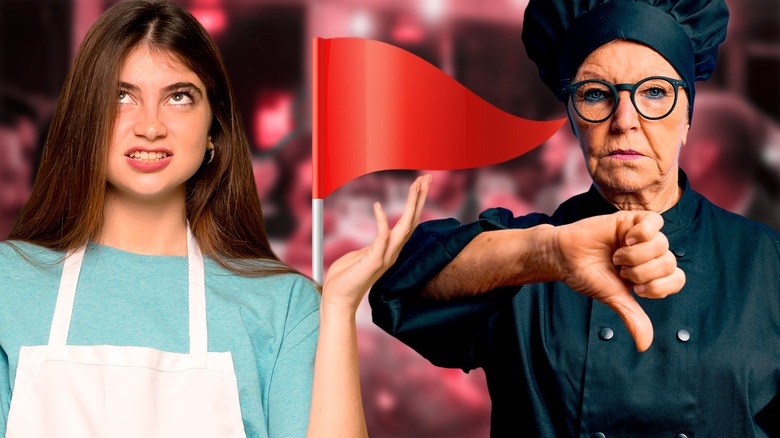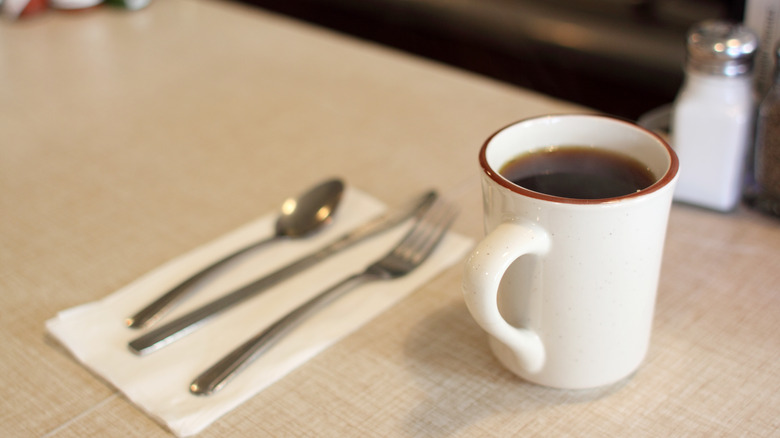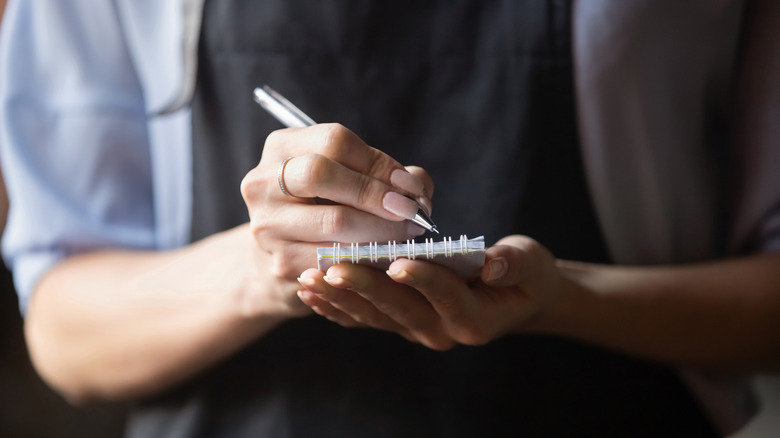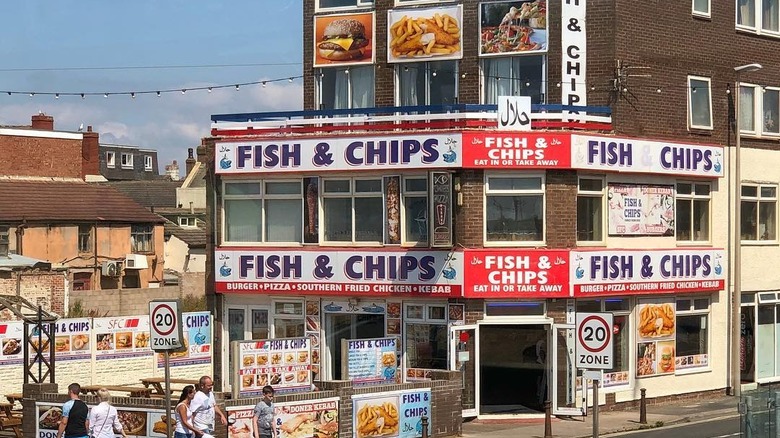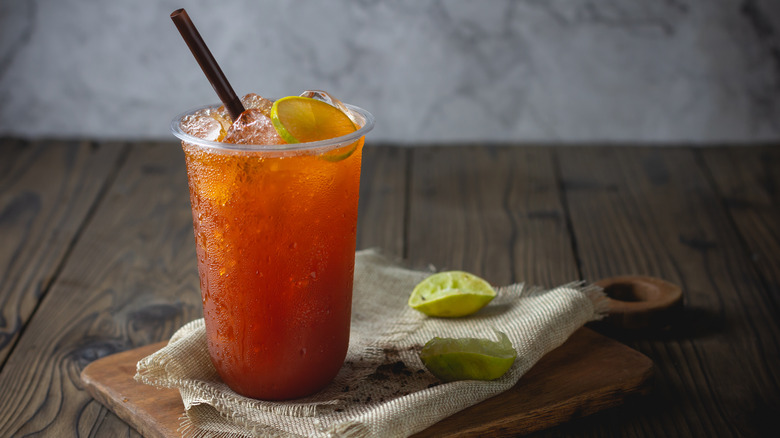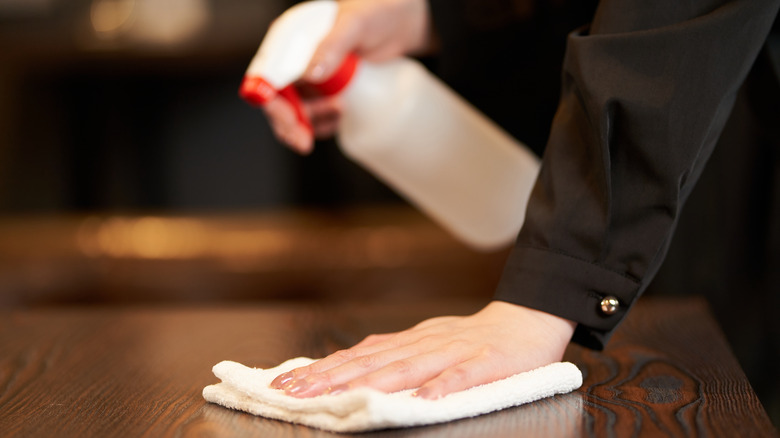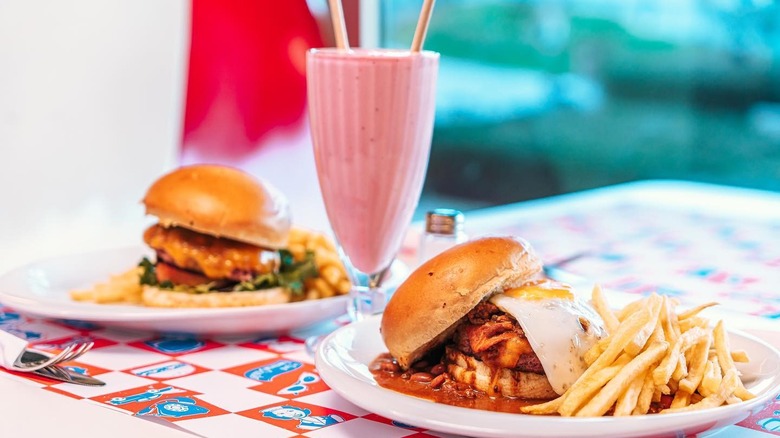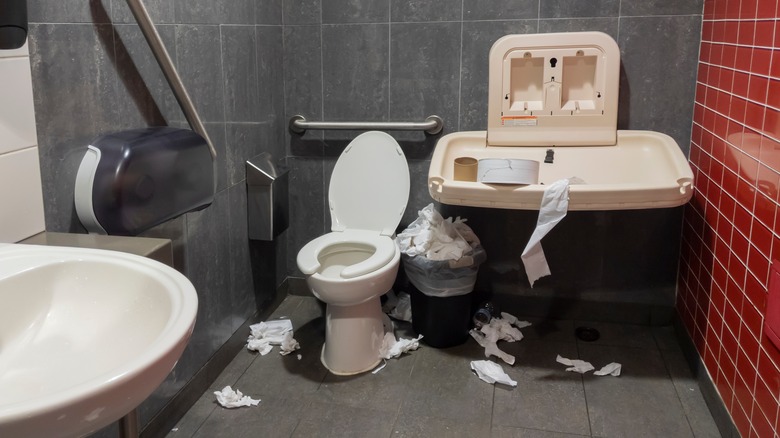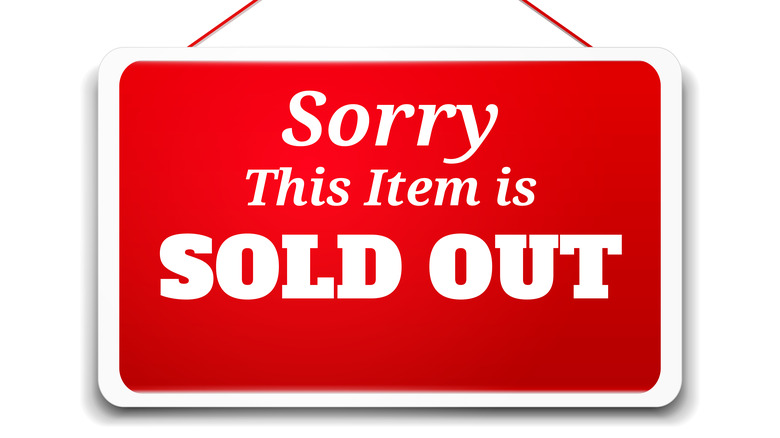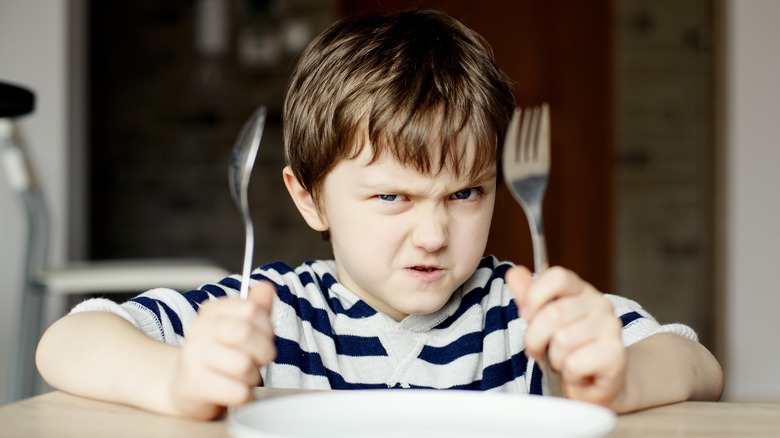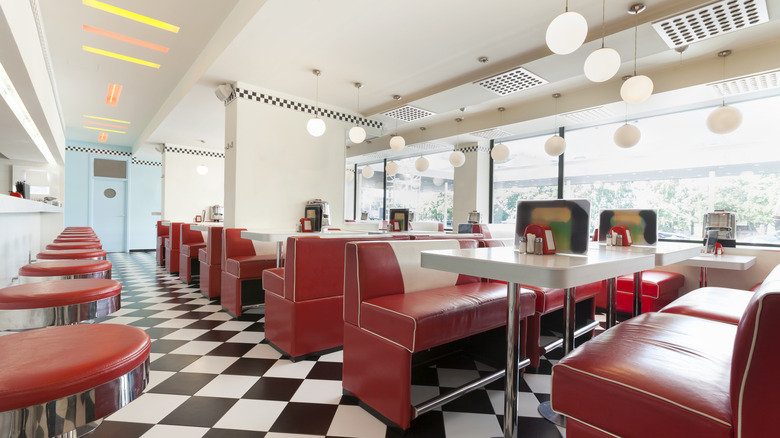14 Red Flags To Look Out For When You're Eating At A Diner
With low prices, late hours, huge menus full of comfort food, and friendly faces, diners have maintained their popularity throughout the years and can feel like a home away from home. Perfect for even the earliest of risers, diners are a one-stop spot for breakfast, lunch, and supper. Modern diners often reimagine the feel of the traditional, quintessential 1950s-style diner, and keep the same concepts of inexpensive, home cooking. We all know of that local diner that has been on the corner for years. Some swear by it, and some say it should've closed a long time ago. So how do you know if you should eat there?
Diners are known for embodying the comfort of home in a setting where you don't have to cook. But just like any restaurant or buffet, a diner can have its flaws. Whether it's an issue of hygiene, customer service, or less-than-appetizing food, it can have signs that indicate you're better off eating elsewhere — even if it's a local, popular haunt. Next time you're eating out at your fave family diner, be on the lookout for some of these red flags.
1. Bad coffee
When a diner has bad coffee, it's bad news. Coffee is a staple at diners, and an unappetizing brew is a big red flag. The perk of endless coffee refills at a diner loses its appeal when it's bitter or burnt. If you're leaving the coffee untouched, you might think of leaving the food uneaten. While good coffee doesn't define a diner, it sure helps. Sometimes, coffee can be saved. A little more sugar or a lot more cream can do wonders. Some think that a pinch of salt can combat the bitterness of coffee, in fact, celebrity chef Alton Brown recommends this trick when brewing it. But if you overdo the salt, you're left with the same problem: gross coffee.
Even so, if you find yourself at a diner salting your coffee or loading it up with extra cream and sugar, then be wary. Poor coffee could be the least of the diner's problems, and there may be more unfortunate circumstances ahead.
2. Instant or microwaved food
If a kitchen is trying to save time or cook in bulk quantities, it may substitute fresh ingredients for those that are instant. Using powdered scrambled eggs or instant mashed potatoes for menu items suggests that the kitchen may not have fresh ingredients in general. While they aren't necessary, per se, they are definitely preferred when dining out. Known for that feel-good, home-cooked meal, diners would benefit from cooking fresh ingredients before choosing to break out that box of potato flakes.
Likewise, several microwaves being used in the kitchen is not a great sign. Even if they are fast, microwaves don't always heat food evenly and it's not the same as cooking it fresh on the griddle, grill, or oven. When you use instant food mixes or microwaves, the dish may taste off. Or it may indicate there isn't a lot of care or skill in the kitchen. That isn't to say you can't love instant potatoes like you would any other potato variety or that microwaved food is not fit to eat, but this quick style of cooking can be a red flag at a diner.
3. Rude employees
Diners are revered for their friendliness and familial feel. When you aren't greeted, or greeted with a blasé attitude, do you expect the rest of your dining experience to come with a smile? Probably not. We know every worker has a hard day, and sometimes it's hard to keep on a friendly face, but in a diner, a smile can make a big difference. Rudeness may suggest poor customer service. It's not a great sign when employees seem unhappy, because it likely means something deeper is going on. Maybe they know the diner isn't a great place to eat, or they don't want to work there. If they're unhappy they may not prepare food properly or be quick to offer a refill of your drink. Either way, mediocre customer service is a red flag that can deter customers.
But sometimes the employees aren't rude; instead, you get the experience of bizarre customer service. Like this Reddit user who waited for 90 minutes, and then received the odd request to run across the street to complete an errand for their server when their meal was done. No doubt about that being a red flag.
4. Excessive signage
Part of the fun of going to a diner is seeing all of the local ads usually plastered onto the table tops. Seeing faces on a printed advertisement for lawn service or realty is a way to connect with the locals. Susan has been serving your small town for 25 years, and that diner is proud to endorse her. Sweet, right? It could even be a green flag when your fave diner is fostering a sense of community.
But excessive promotional signs at a diner are a red flag. As Gordon Ramsay will tell you, too many signs usually means the diner is failing in some way, and hoping to detract from shortcomings. A few signs or advertisements aren't necessarily bad, but several signs, or dilapidated signs scream that something is up. When you see various signs cluttered on the front of the diner — "World's Best Burger!" (Is it, though?); "Grand Re-Opening" (Hmm, what happened the first time?); "50% off" (Why is it so cheap?) — maybe consider backing away and eating at another establishment.
5. No iced tea or using fountain stations
A diner, especially one with Southern cuisine, should always have tea brewed and ready to go. If it doesn't have any tea, it's probably not a good sign. It can mean they are serving inauthentic food or aren't a traditional diner. A cold glass of iced tea, poured by a server, can even bring a sense of nostalgia for which diners are known.
It's best to know that tea is coming straight from a pitcher, too. Having to get your own drink at a fountain station isn't ideal as there is a bigger chance of spreading bacteria. Some studies have reported findings of E. coli and other bacteria in fountain drink stations while other researchers have discovered mold, bleach, insects, and even fecal bacteria. Yuck. If the employee gets the drinks for you, it means fewer hands touch the station, leading to the spread of fewer germs. (Preferably, they are also cleaning it properly to prevent germs.) Diners are all about keeping it cozy and comfortable, but that doesn't mean it has to be self-service for drinks.
6. Sticky surfaces
There's instant regret when you step into a diner and start sticking to the floors as you walk. Add even more regret if the tables or menus are sticky, too. Oftentimes, this indicates bad hygiene. If the dining surfaces are dirty, it's likely the kitchen could be dirty, too. No one wants to dine at an establishment where they are touching old jelly or food grease. A few crumbs don't suggest a disastrous experience ahead, but a significant mess is indubitably a bad sign.
It leaves a bad impression when a customer touches leftover, sticky food. Besides that, it's a big health concern. If there's food gunk, it suggests there could also be germs that cause illness. In today's age, a simple sneeze can send folks running. Imagine you sat down to eat at a diner, touched an unidentified mess on the table or menu, and then witnessed someone (server or diner) coughing or sneezing. Your fear of catching those germs is automatically justified. In short, dirty tables and menus can do more than cause a scrunched nose: They can create additional worries about hygiene and ward off customers.
7. Few healthy options
No, diners are not notorious for healthy menu options with their famed milkshakes and fried food, but to have zero or very few healthier options is definitely a red flag. Nowadays, many diners offer low-calorie or heart-healthy menu items. Some classic meals, like a BLT or bowl of chili, are to be considered healthier things to eat at a diner. Rich and hearty, chili is also full of nutrients with ingredients like peppers, onions, and beans. (Note: Chili is not the same as chili cheese fries.)
Another healthier option, the beloved BLT, composed of a little bacon, lettuce, and tomato on some wheat bread, is a better choice than, say, a loaded cheeseburger. In fact, since bacon is full of protein, vitamins, and iron, it can be somewhat nutritious — in moderation, of course.
If you're seeking healthier options, some meals should be avoided. Omelets, for example, are a nutritious dish until extra ingredients, like cheese and meats, are added. A meat lover's omelet is packed with sodium and calories when meats like bacon, ham, and sausage are substituted for vegetables. Some diners offer eggs as whites-only in an effort to promote a heart-healthy option. When a diner accommodates the diets of those wanting to avoid unhealthier foods, it's a good sign, as opposed to a diner with no alternatives.
8. Dirty bathrooms
Need we say more? Any diner with a dirty bathroom probably has a dirty kitchen or dining area. Especially when there is only a single restroom for customers and employees. If it's not clean, it means the diner may be overall unhygienic. Without a doubt, a dirty bathroom is a red flag. Aside from being a bad sign, it's also a risk to customers' health. We don't think we need to go into how gross a restroom can become — it's obvious that kind of unsanitary environment reflects poorly on a dining establishment.
This doesn't just go for diners, either. If you go out to a Michelin-star restaurant and find a mess in the restroom, you probably wouldn't want to return or even continue eating. Sometimes we wish we could walk through a kitchen before entering the dining room, just to check it out. Since that's not usually an option, the next best is scoping out the bathroom before eating.
9. Bad reviews
While reviews on the internet aren't always common for local diners, word-of-mouth also travels pretty far. No matter how you hear about it, it's not a good sign if there are a lot of negative reviews about a diner. According to a survey done by TripAdvisor, 94% of American respondents said they decide which diner to eat by reading online reviews. If you're curious about the standards of one of your favorites, you can also visit the website of your city's health department, where they typically have the results of restaurant inspections available for public access. A bad inspection obviously counts as a bad review, and it's a glaring red flag.
Keep in mind that customer reviews are a matter of personal experience, and some may be biased because of their preferences. Not every diner will always be pleased, every time. Sometimes, kitchens or servers make mistakes — we are human, after all. Sift through reviews and notice any repeating phrases or problems. Do a lot of reviews state something about a negative experience: poor service, lack of cleanliness, or bad food? If so, maybe steer clear of that diner.
10. Unavailable menu items
If a diner is out of menu items, it might mean they aren't ordering or cooking food fresh and may be waiting on shipments of pre-cooked or frozen items. In most cases, a kitchen should be fully stocked with its regular menu items. If not, the diner should update the menu. Outdated menus with unavailable items are definitely a red flag that something dubious might be going on in that kitchen.
Moreover, it can be frustrating when you keep ordering menu items that aren't available. And we're not talking about items not visibly on the menu, such as with secret menus. There are some instances where unavailable ingredients make sense, such as diners that cook with only a limited amount of fresh ingredients each day. Once they are gone, that's it, and they close until the next day. Usually, this happens when an eatery offers only breakfast and brunch. With diners, the long hours and three-course menus imply they have a full menu available all day. When a diner turns down multiple choices, it comes across as misleading.
11. Littered parking lot
We all know the saying that you only get one chance to make a first impression. Well, the parking lot is the first place a customer sees, and if there is trash scattered throughout, that impression is going to be pretty sour. A diner that doesn't put care and attention towards its exterior appearance might not put a lot of care and attention towards the interior, either. Neglected parking lots suggest the establishment might have poor or lazy management or a lack of pride and love for their diner.
On top of that, trash or overflowing dumpsters can attract rodents, bugs, and an undesirable odor. Aside from food debris, plastic and other litter can be harmful to the environment. In a way large franchise restaurants do not, local diners are often a reflection of their community, typically being owned and operated by families with a history in the area — and a littered lot isn't going to indicate love. If a diner isn't keeping up with cleaning its outside premises, it's a red flag. We wouldn't blame you if you drove away before even trying the food.
12. Large quantity of menu items
Diners are known for big menus with big pictures — they are sometimes the exception to the "restaurant rule" that large menus with pictures indicate a lack of class or unfavorable food. In a diner, oversized menus with pictures simply don't come across as tacky like they might at an upper-scale restaurant.
However, a menu with a large number of dishes to order is a red flag. Having so many options can suggest that many food items are frozen or pre-cooked, which is why it can carry such a variety. The phrase "jack of all trades, master of none" is usually at the forefront of the mind when seeing a massive, unfocused menu. If there is too expansive of a menu, with breakfast, pizza, gyros, sandwiches, burgers, and flatbreads, and barbeque, and seafood — they probably aren't cooking it all right.
13. Unsatisfied diners
If other diners seem frustrated or displeased, it could be your turn next. It is a red flag when the other people dining at the restaurant have a look that implies they are having a bad experience. If there are no plates on the tables perhaps the customers have been waiting on their food for a while. And if there are no drinks either, then the service may be less than stellar because that's the first thing you usually get. Any of these reasons are enough to make for unhappy customers.
Lots of smiles and conversation? That's a good sign. It means people are likely enjoying themselves, the food, and the service. But a near-empty diner with poor service, or a full diner with multiple frowns shows that it is probably not a great place to eat. It is not likely that everyone eating there is having a bad day — they're probably having a bad time there.
14. Long wait when it's not busy
If it takes over an hour to get your food when you are one of a few diners, it's a red flag. While fresh meals take time to cook, there's no reason it should take an unreasonable amount of time if it isn't busy. It could mean they are understaffed, or less than skilled. In any case, it doesn't bode well. Slow service can quickly get on a customer's nerves, especially when they're hungry. Hangry is a real emotion, and when hunger and anger combine, it's not good for anyone nearby.
Various Reddit threads have complaints of long waits with few customers, and the general consensus is resounding: It's bothersome, unacceptable, and a good enough reason to leave or never eat there again. It could also point to a larger issue, coming back to unhappy employees.
